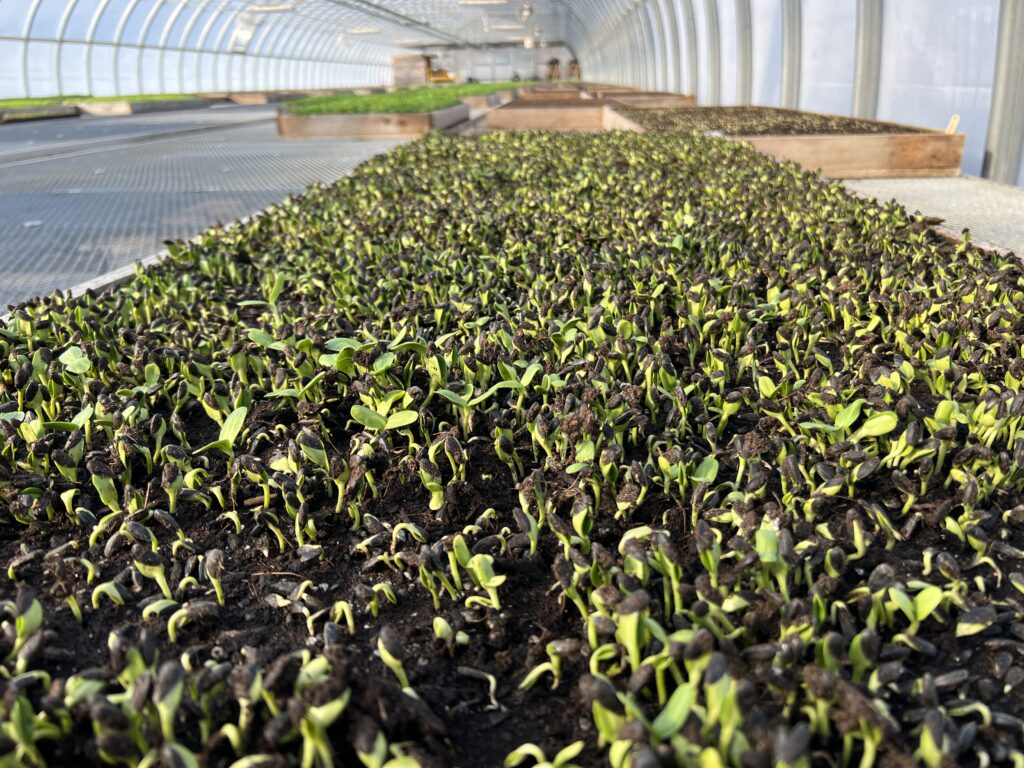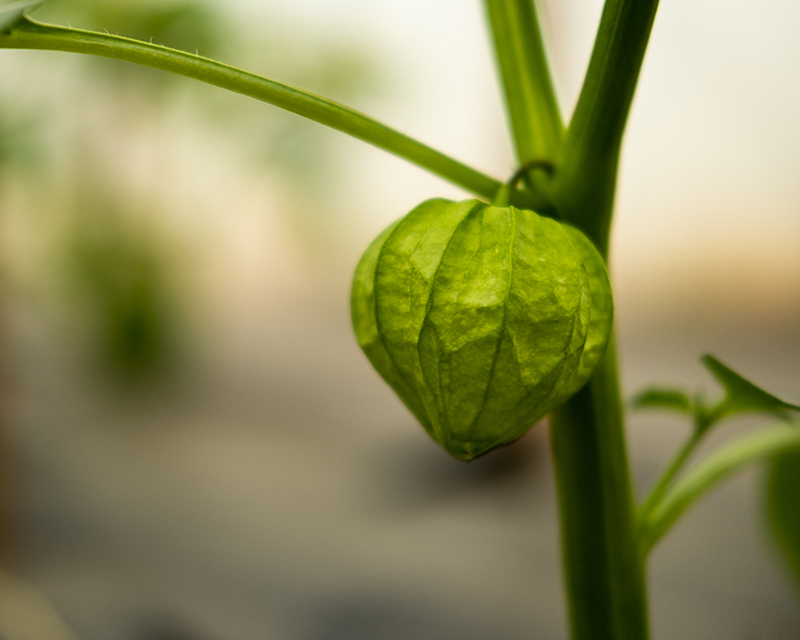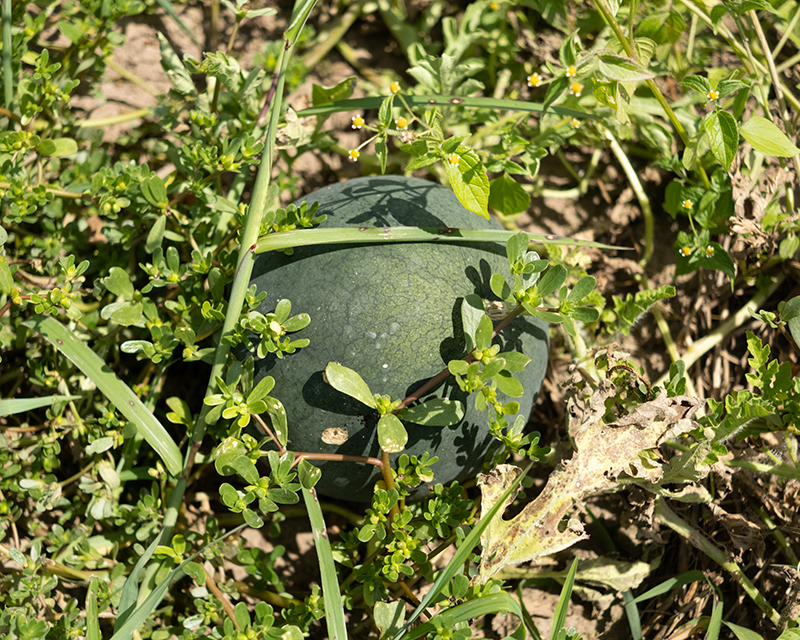Leer en Español
A tropical spice makes its debut for food distribution and cultural connection
By Jenny Linger, Vegetable Production Co-Manager

This summer we grew ginger for the first time at the Farm Hub. Flats of ginger were seeded to sprout in the balmy conditions atop heat mats in April, transplanted in the bed between basil and tomatoes in June, and harvested from the high tunnel in October. The harvest required digging under the plants to loosen them from the soil — the plants were gradually mounded with soil to encourage rhizome growth in the warm, crumbly topsoil. Once the rhizomes are freed, stems and leaves were trimmed off and roots were sprayed clean. They were then dried on wire racks before being packed into cases for distribution. In total, some 400-plus pounds of ginger were harvested. Because fresh uncured ginger is a perishable product, cases were at once distributed into the emergency feeding system in the City of Kingston and surrounding communities.
How and why would we grow ginger here in New York?
We decided to incorporate ginger, a flowering rhizome, into our mix of greenhouse crops for many reasons, including diversifying our crop rotation and maximizing greenhouse space between tomatoes and cucumbers. Hundreds of northeast growers have been growing it for the compelling reasons of claiming a share of the premium price (up to $20 per pound) and adding a novel offering to their market table that appeals to many of their customers.

Ginger is intrinsically exotic in its fresh form. Between its spiced citrus aroma, bushy palm like leaves, and neon yellow fibers, it is easy to picture it nestled in an understory of bananas, coconuts, plantains, or coffee. In fact, one of our production team members remembers growing and selling it as a child with her mother in a market in Guatemala and collecting flower buds for soups. Unsurprisingly, ginger is one of the most frequently used cooking spices and aromatics in the world found in chicken soup, stocks, curries, stir fry, candies, soda, soups, pies, and teas. Pickled, candied, powdered, sliced, grated, frozen – it’s easy to use and easy to love. It is also a highly nutritious food known for its curative compounds that ease nausea, stomachache, and inflammation. Across hundreds of cultures, it serves as a food medicine and is widely appreciated by our donation partners in building a more salubrious food system.
In pursuing its mission of social and ecological regional resilience, the Farm Hub has focused on bolstering food security, an initiative underscored by the donation of 99.9% of our organic produce to our partners embedded in the local and regional emergency feeding system. Despite being portrayed for decades as a foreign or global issue, food insecurity is today considered endemic to the US and a true marker of poverty born of vast societal inequities. In 2021, Ulster County reported that 12% of its population reported food insecurity (the world figures are at just over 8%) and 1 in 7 residents lived in poverty.
For our donation partners and their clients, questions arise: How will this food be prepared and enjoyed? Is there sufficient nutrition and diet diversity? And perhaps most importantly, is it familiar and within a multicultural palate, does it taste good? Every year our Food Access, Distribution, and Production teams work together to change and evolve the crop plan based on feedback from donation partners, our own production teams, and current research and development from local agronomists. This year our donation partners asked for increased offerings of a variety of crops including crops specific to Latinx community members. We also had requests for more fruit and heard an overwhelming appreciation for providing local produce in the winter.
Cultural connection
Ginger is one of a handful of crops we have branched into while seeking crops to build greater diversity and cultural relevance. We had some real wins both agriculturally and distribution-wise: overwintered scallions and spring onions, summer successions of cilantro and basil, seedless watermelon, cantaloupes, leafy collards, and crispy sunflower shoots.



Sunflower shoots, tomatillos, and seedless watermelons add to the array of crops introduced in recent years.
That said, as farming is often unpredictable and at the mercy of changing elements including weather, we’ve also had a few duds – including aphid eaten greenhouse tomatillos and some less popular vegetables. After an extremely weedy section of parsnips that had to be preemptively turned under this year, we won’t grow parsnips in the foreseeable future. They just don’t check enough boxes for us – they’re not particularly nutritious, efficiently cultivated, nor popularly desired by partners or their clients.
This coming 2024 season, we’ll be expanding solanaceous crops beyond the greenhouse and into the field, so that we can make room for more sauce, Roma, and cherry tomatoes and the hot and sweet peppers that our partners love. As always, we’ll continue with more vegetables and variety trialing. If you’re a donation partner, client, gardener, chef, or eater, what foods would you love to see us grow? Send your ideas to [email protected].

Ginger is versatile and easily used in carrot or butternut squash soup, sliced into ginger lemon honey tea, ginger spiced stovetop applesauce, minced in stir-fry, boiled into broths and chicken soup, juiced with root vegetables and greens, added to vegetable ferments like kimchi or hot sauce recipes. It has medicinal value in easing nausea and stomachaches as well as containing antioxidants.
KayCee Wimbish, Project Director and Farmer of the Kingston YMCA Farm Project shared her favorite ginger recipe with us.
“I made so much ginger tea for me and my son when we were dealing with respiratory illnesses. I just sliced the ginger thin and let it steep in boiling water for up to 30 minutes. Then I added lemon and honey and we both loved the healing effects of it.”
Video: Harvesting Ginger
Enjoy the short video of our ginger harvest here.
